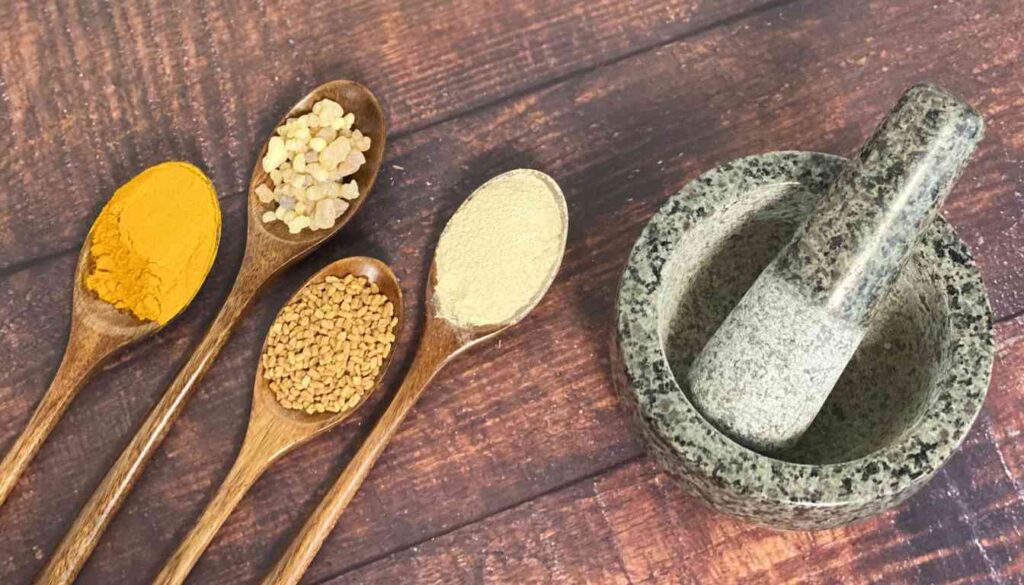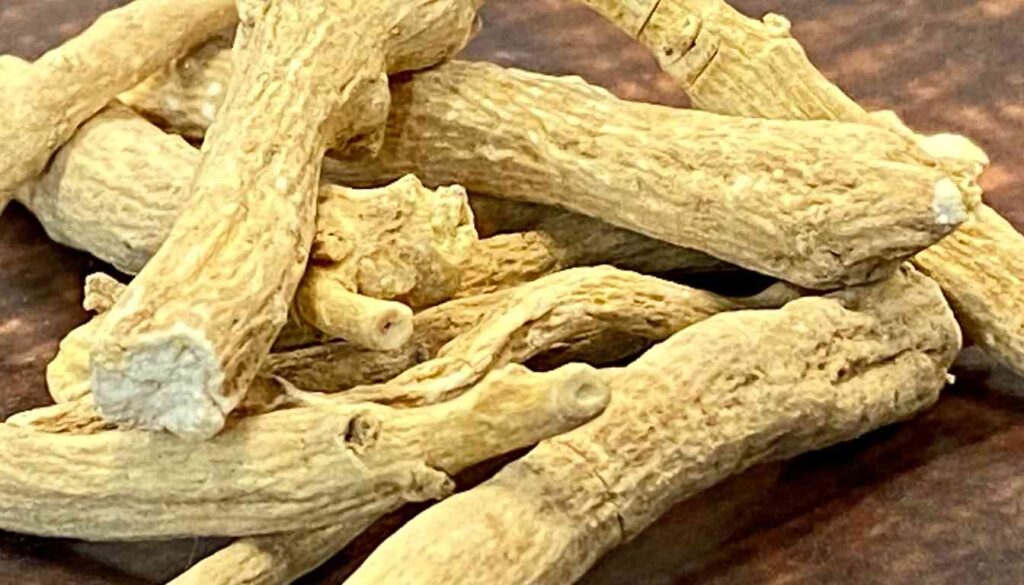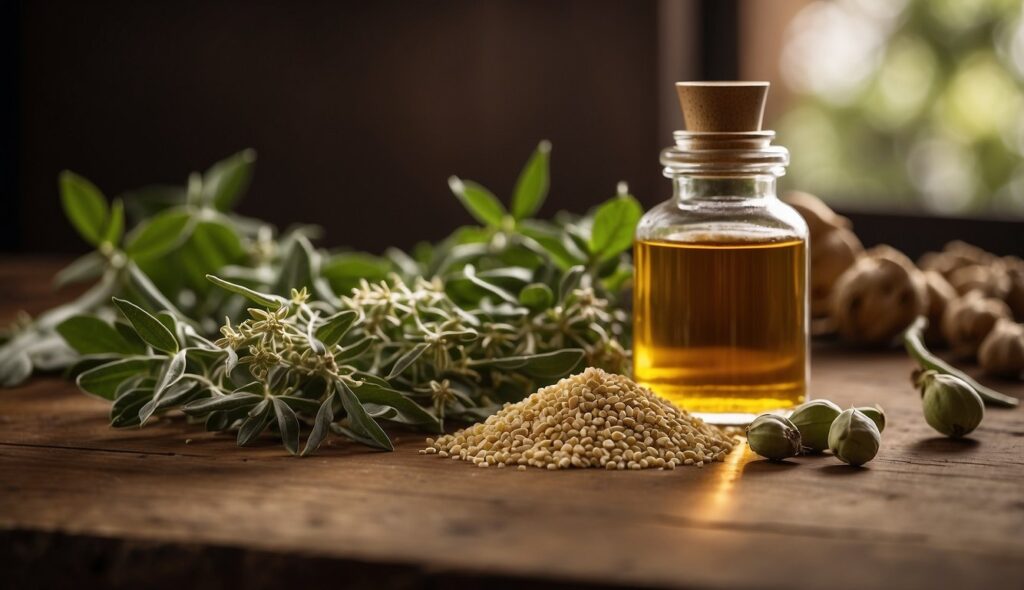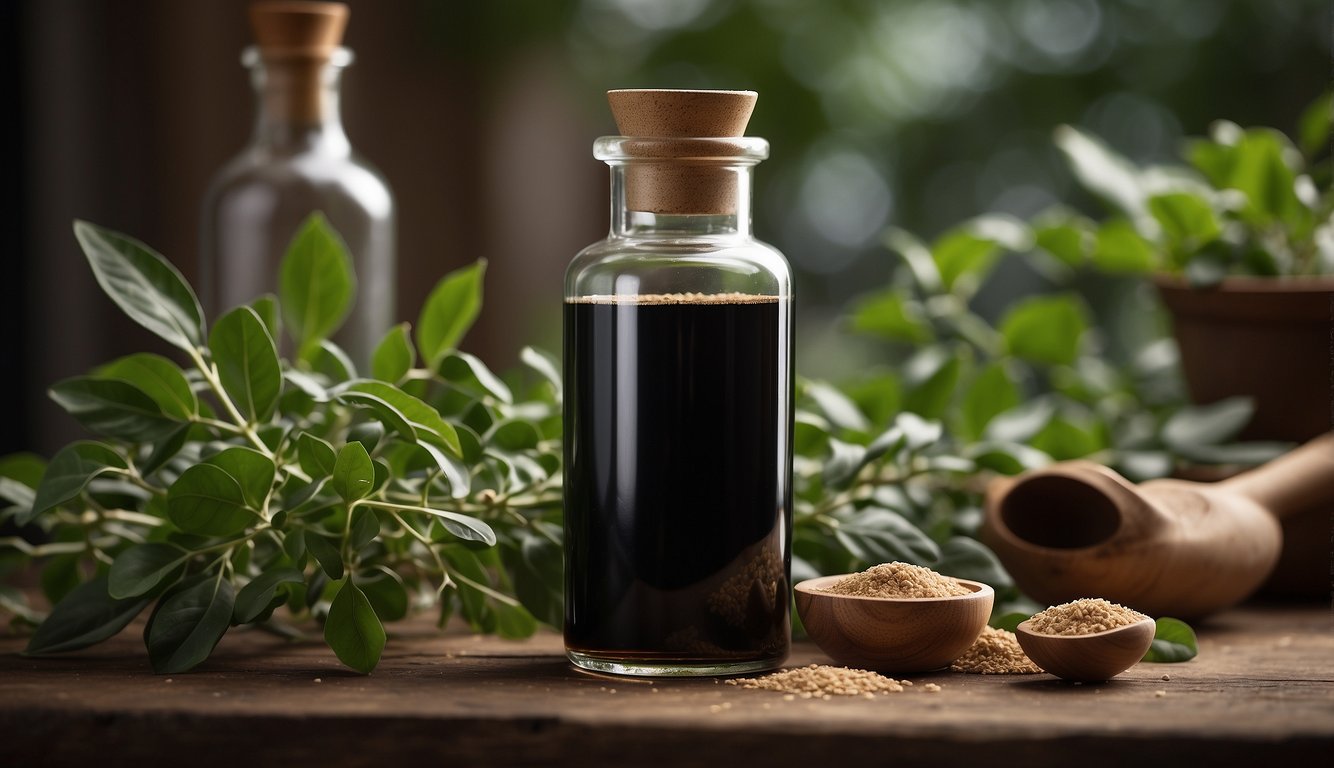Ashwagandha is an adaptogenic herb used in Ayurvedic medicine for centuries. It’s known for promoting overall health by reducing stress, anxiety, and inflammation. One popular way to consume ashwagandha is by making a tincture. Crafting an ashwagandha tincture recipe is relatively easy and needs just a few simple ingredients.
The most important ingredient is ashwagandha root, which can be purchased dried and cut.
Vodka or rum is used as the solvent to extract the beneficial compounds from the root.
The resulting tincture can be taken directly or added to a beverage for an extra health boost.
Benefits of Ashwagandha Tinctures Recipe
As someone who has been using ashwagandha tinctures for a while now, I can attest to the many benefits that this herb has to offer. Here are some of the most notable benefits of ashwagandha tinctures:
Supporting Stress and Anxiety Relief
Ashwagandha is effective in reducing stress and anxiety levels.
It works by regulating cortisol levels in the body, which is the hormone that is released in response to stress.
By reducing cortisol levels, ashwagandha can help alleviate the symptoms of stress and anxiety, such as restlessness, irritability, and fatigue.
Boosting Immunity and Overall Health
Ashwagandha is also known for its immune-boosting properties.
It is rich in antioxidants and has anti-inflammatory effects, which can help protect the body against disease and infection.
Additionally, ashwagandha has been shown to have a positive effect on overall health, including improving brain function, reducing inflammation, and lowering blood sugar levels.
Enhancing Sleep and Reducing Fatigue
Another benefit of ashwagandha tinctures is their ability to enhance sleep quality and reduce fatigue.
Ashwagandha has a calming effect on the body and can help to promote relaxation, making it easier to fall asleep and stay asleep.
Additionally, ashwagandha can help to reduce fatigue and increase energy levels, making it a great option for those who struggle with low energy or chronic fatigue.
Understanding the Ingredients – Ashwagandha Tincture Recipe
When it comes to making an ashwagandha tincture, choosing the right ingredients is crucial. In this section, I will discuss the two main ingredients you’ll need for your tincture: ashwagandha and a solvent.
Choosing the Right Ashwagandha
The first ingredient you’ll need for your ashwagandha tincture is, of course, ashwagandha.
Ashwagandha is a powerful adaptogenic herb that has been used for centuries in Ayurvedic medicine to help the body cope with stress and anxiety.
When selecting your ashwagandha, it’s important to choose a high-quality source.
Look for organic and non-GMO ashwagandha to ensure that it hasn’t been treated with pesticides or other harmful chemicals.
You can choose to use either cut or powdered ashwagandha root for your tincture, depending on your preference.
Selecting Your Solvent
The second ingredient you’ll need for your ashwagandha tincture is a solvent.
The solvent is used to extract the beneficial compounds from the ashwagandha root and preserve them in liquid form.
The most common solvent used for making tinctures is high-proof alcohol, such as vodka or brandy.
When choosing your alcohol, look for a non-GMO, high-proof alcohol that is at least 80-proof. This will ensure that it has enough alcohol content to effectively extract the beneficial compounds from the ashwagandha root.
If you prefer not to use alcohol, you can also use vegetable glycerin as a solvent.
Glycerin is a sweet, viscous liquid that is derived from plants and is an effective solvent for extracting the beneficial compounds from ashwagandha.
When using glycerin, be sure to use a high-quality, organic product to ensure that it is free from harmful chemicals.
In addition to alcohol and glycerin, you can also use a combination of water and alcohol as a solvent.
This is known as a double extraction method and can be an effective way to extract both water-soluble and alcohol-soluble compounds from the ashwagandha root.
Preparation Essentials – Ashwagandha Tincture Recipe
Proper Ratios and Measurements
To make a potent ashwagandha tincture, it is important to use the correct ratios and measurements.
I recommend using a ratio of 1 part ashwagandha root to 4 parts high-quality alcohol such as non-GMO vodka or rum.
This means that for every 1 cup of dried ashwagandha root, you will need 4 cups of alcohol. You can adjust the ratio based on your preference, but keep in mind that a higher ratio of ashwagandha root will result in a more potent tincture.
Cleanliness and Equipment
Cleanliness is crucial when making ashwagandha tincture. Make sure all equipment, including jars, measuring cups, and food processors, are thoroughly cleaned and dried before use.
It is also important to use a glass jar with a tight-fitting lid to prevent any contamination.
I recommend using a food processor to grind the ashwagandha root into a fine powder before adding it to the alcohol.
Combining Ingredients
To make the tincture, simply add the ground ashwagandha root to the glass jar and pour in the alcohol.
Make sure the alcohol completely covers the ashwagandha powder. You can adjust the amount of alcohol as needed to ensure complete coverage.
Seal the jar tightly and shake it vigorously to combine the ingredients.
Store the jar in a cool, dark place for 2-4 weeks, shaking it daily to help the ingredients infuse together.
Step-by-Step Ashwagandha Tincture Recipe

As someone who regularly makes ashwagandha tincture, I can attest to how easy and rewarding it is to make your own. Not only is it cost-effective, but you can also customize the flavour and potency to your liking. Here is my step-by-step guide for making ashwagandha tincture.
Mixing Ashwagandha and Alcohol
To start, you’ll need to gather your ingredients.
You’ll need dried ashwagandha root and a high-proof alcohol, such as vodka or rum.
I recommend using a non-GMO brand for the most health benefits.
To mix the ashwagandha and alcohol, use a 1:4 ratio. For example, if you have 1 cup of dried ashwagandha root, you’ll need 4 cups of alcohol.
You can adjust this ratio to make a stronger or weaker tincture, depending on your needs.
Place the dried ashwagandha root in a glass jar and pour the alcohol over it. Make sure the root is fully submerged in the alcohol. You can add other flavorings, such as cinnamon or honey, at this stage if you desire.
Storing and Aging the Tincture
Once you’ve mixed the ashwagandha and alcohol, store the jar in a cool, dark place for 4-6 weeks.
I recommend shaking the jar daily to help extract the medicinal properties of the ashwagandha root.
During this time, the alcohol will extract the active compounds from the ashwagandha root, resulting in a potent tincture. The longer you let it sit, the stronger it will become.
Filtering and Bottling
After 4-6 weeks, it’s time to filter and bottle your tincture.
Use a cheesecloth or strainer to separate the liquid from the ashwagandha root. You can discard the root or save it for another use.
Next, transfer the tincture to a dropper bottle for easy use. I recommend using amber glass bottles to protect the tincture from light and extend its shelf life.
Enhancing Your Tincture – Ashwagandha Tincture Recipe
If you’re looking to take your ashwagandha tincture to the next level, there are a few ways to enhance its flavor and benefits. Here are a couple of ways to get started:
Incorporating Additional Herbs and Spices
One way to enhance your ashwagandha tincture is to incorporate additional herbs and spices.
For instance, you could add a pinch of cinnamon to your tincture to give it a warm, spicy flavor.
Cinnamon is also known for its anti-inflammatory properties, making it a great addition to your tincture.
Another herb you could consider adding is ginger.
Ginger has a long history of use in traditional medicine and is known for its anti-inflammatory and antioxidant properties.
Adding a small amount of fresh ginger root to your tincture could give it a pleasant, spicy kick while also boosting its health benefits.
Creating a Unique Flavor Profile
If you’re looking to create a unique flavor profile for your tincture, there are a few things you could try.
For example, you could sweeten your tincture with a bit of honey.
Honey is a natural sweetener that also has antibacterial and anti-inflammatory properties, making it a great addition to your tincture.
Another way to create a unique flavor profile is to experiment with different spices.
For example, you could add a pinch of cardamom or nutmeg to your tincture to give it a warm, earthy flavor.
Alternatively, you could try adding a bit of vanilla extract to your tincture for a sweet, floral flavor.
Usage and Dosage – Ashwagandha Tincture Recipe
Ashwagandha tincture is a popular herbal remedy that is easy to use and offers numerous health benefits. However, it is important to use the correct dosage to avoid any potential side effects.
Determining the Right Dosage
The recommended dosage of ashwagandha tincture varies depending on the brand and concentration. It is important to read the label and follow the instructions carefully.
In general, a typical dose is around 1-2 mL, taken 1-2 times per day. However, some people may require higher doses to achieve the desired effect.
Some people prefer to take ashwagandha in capsule form, which can be a convenient option for those who are always on the go.
Methods of Consumption
Ashwagandha tincture can be consumed in a variety of ways. One common method is to add a few drops to a glass of water or juice and drink it daily.
Another option is to mix the tincture with a small amount of honey or maple syrup to improve the taste.
Ashwagandha powder can also be added to smoothies or other beverages for a quick and easy way to consume the herb.
Regardless of the method of consumption, it is important to use a dropper to measure the correct dosage. This will ensure that you are getting the right amount of ashwagandha and will help to avoid any potential side effects.
Also, some people prefer to take ashwagandha in capsule form, which can be a convenient option for those who are always on the go.
It is also important to note that ashwagandha may interact with certain medications, so it is important to talk to your doctor before starting any new supplement regimen.
Safety and Considerations – Ashwagandha Tincture Recipe

Understanding Potential Side Effects
As with any supplement or medication, it is important to understand the potential side effects of ashwagandha tincture.
While ashwagandha is generally considered safe for most people, some individuals may experience mild side effects such as upset stomach, diarrhea, or nausea. In rare cases, more serious side effects such as allergic reactions or liver damage may occur.
Individuals with medical conditions such as autoimmune disorders, diabetes, or thyroid function issues should consult with their healthcare provider before using ashwagandha tincture.
Additionally, pregnant or breastfeeding women should avoid using ashwagandha tincture as there is not enough research to determine its safety during these times.
Interactions with Other Medications
Ashwagandha tincture may interact with certain medications, including blood pressure medications, sedatives, and thyroid hormone replacement therapy. If you are taking any medications, it is important to consult with your healthcare provider before using ashwagandha tincture to avoid any potential interactions.
It is also important to note that ashwagandha tincture may have a sedative effect and should not be taken with other sedatives or alcohol.
Additional Health Applications – Ashwagandha Tincture Recipe
Ashwagandha is a versatile herb that has been used for centuries in Ayurvedic medicine. In addition to its use as a stress-relieving adaptogen, ashwagandha has several other health benefits.
Ashwagandha for Joint and Muscle Health
Ashwagandha has been shown to have anti-inflammatory properties, which makes it a promising natural remedy for joint pain and arthritis.
The active compounds in ashwagandha, including withanolides and withaferin, have been shown to reduce inflammation and pain in animal studies. In addition, ashwagandha has been shown to improve muscle strength and endurance in humans, making it a potential supplement for athletes and fitness enthusiasts.
Cognitive Benefits and Memory Support
Ashwagandha has also been studied for its cognitive benefits, particularly its effects on memory and brain function.
One study found that ashwagandha extract improved memory and cognitive function in people with mild cognitive impairment. Another study found that ashwagandha supplementation improved reaction time and task performance in healthy individuals.
In addition, ashwagandha has been shown to have neuroprotective effects, which means it may help protect the nervous system from damage and degeneration. This makes ashwagandha a potential supplement for people with conditions that affect the nervous system, such as Alzheimer’s disease or Parkinson’s disease.
Preservation and Storage – Ashwagandha Tincture Recipe

As with any homemade herbal tincture, proper preservation and storage are essential for maintaining the potency and quality of the ashwagandha tincture. Here are some tips to ensure that your ashwagandha tincture lasts as long as possible:
Optimal Conditions for Longevity
The best way to preserve the potency of the ashwagandha tincture is to store it in a cool, dark place.
The ideal temperature range for storing tinctures is between 60 and 80 degrees Fahrenheit, and the best place to store them is in a dark cabinet or pantry.
Exposure to sunlight and heat can cause the tincture to degrade more quickly, so it’s important to keep it away from direct light and heat sources.
Another way to extend the shelf life of your ashwagandha tincture is to use cobalt glass bottles.
These bottles are designed to block out light and protect the tincture from UV radiation. Cobalt glass bottles are also airtight, which helps to prevent oxidation and maintain the potency of the tincture.
Labelling and Organization
Proper labelling and organization are also important for preserving the quality of the ashwagandha tincture.
Make sure to label your tincture bottles with the date of creation and the ingredients used. This will help you keep track of the age of the tincture and ensure that you use it before it loses its potency.
It’s also a good idea to keep your tincture bottles organized by type and potency. This will make it easier to find the tincture you need when you need it, and it will also help you keep track of which tinctures are the most potent and which ones are starting to lose their potency.
Fusing “Ashwagandha Tincture Recipe” with TheHerbProf.com
Ashwagandha Tincture Recipe, my herbal comrades, is like a secret key in the treasure chest of herbalism. It’s a tool that unlocks the power of nature’s bounty. But what’s a key without a lock? That’s where TheHerbProf.com steps in!
Think of TheHerbProf.com as a grand treasure chest. It’s filled with ancient scrolls, magical herbs, and mystical knowledge. It’s the place where the magic of the Ashwagandha Tincture Recipe is truly understood and appreciated. You can check our homepage here.
Now, let’s flip the coin. TheHerbProf.com is a beacon of herbal wisdom. But what’s a beacon without a beam? That’s where the Ashwagandha Tincture Recipe fits in. It’s the radiant beam that emanates from the beacon that is TheHerbProf.com.
By linking the Ashwagandha Tincture Recipe to TheHerbProf.com, we’re not just creating a hyperlink. We’re creating a bond. A bond where knowledge meets practice, where wisdom meets application, and where theory meets reality.
So, let’s brew some Ashwagandha Tincture, let’s delve into TheHerbProf.com, and let’s embark on an exciting journey into the enchanting world of herbalism together. After all, every journey begins with a single step, and every step is a step closer to the treasure that is herbal wisdom!
References – Ashwagandha Tincture Recipe
Little Herb Encyclopedia, by Jack Ritchason; N.D., Woodland Publishing Incorporated, 1995
The Ultimate Healing System, Course Manual, Copyright 1985, Don Lepore
Planetary Herbology, Michael Tierra, C.A., N.D., Lotus Press, 1988
Handbook of Medicinal Herbs, by James A. Duke, Pub. CRP Second Edition 2007
The Complete Medicinal Herbal, by Penelope Ody, Published by Dorling Kindersley
Check the Following Articles!
Goldenrod Tincture Recipe: Making Step-By-Step
Passion Flower Tincture Recipe: Make Your Natural Remedy
Three Ships Dew Drops Review: The Popular Facial Serum
Hops Tincture Recipe: A Simple and Effective Guide
Frequently Asked Questions – Ashwagandha Tincture Recipe
1. What are the benefits of taking an ashwagandha tincture?
Ashwagandha tincture has been shown to have numerous health benefits. It is commonly used to reduce stress and anxiety, improve brain function, and boost immunity.
Additionally, ashwagandha tincture may help to lower cortisol levels, reduce inflammation, and improve sleep quality.
2. How does the efficacy of ashwagandha tincture compare to its powder form?
Ashwagandha tincture is more potent than its powder form. This is because the tincture is made by steeping the herb in alcohol, which extracts the active compounds more efficiently.
As a result, ashwagandha tincture has a higher concentration of beneficial compounds than the powder form.
3. What is the recommended dosage for ashwagandha tincture?
The recommended dosage of ashwagandha tincture varies depending on the individual and the reason for use. However, a typical dosage is around 30-60 drops, taken two or three times per day.
It is important to consult with a healthcare professional before starting any new supplement regimen.
4. What is the proper way to administer ashwagandha tincture?
Ashwagandha tincture can be taken directly by placing the drops under the tongue or by adding it to a beverage.
It is important to shake the bottle well before administering it to ensure an even distribution of the active compounds.
5. Which type of alcohol is optimal for creating an ashwagandha tincture?
The optimal type of alcohol for creating an ashwagandha tincture is high-proof alcohol, such as vodka or rum. This is because high-proof alcohol extracts the active compounds more efficiently than lower-proof alcohol.
6. What extraction method is most effective for producing ashwagandha tincture?
The most effective extraction method for producing ashwagandha tincture is the traditional method. This method involves steeping the herb in high-proof alcohol for several weeks. It allows for the maximum extraction of the active compounds, resulting in a potent and effective tincture.

